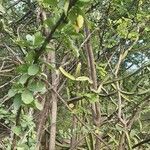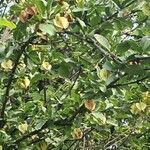A small tree or a woody climber. It loses its leaves during the year. The flowers usually develop before the leaves. The bark is grey to brown. The small branches are often pale. The leaves are opposite. The leaf blade can be 20 cm long by 11 cm wide. It is often smaller. It is papery to leathery. They are oval and hairy when young. They taper to the tip and are rounded at the base. There is a curved spine on the leaf stalk. The flowers are in spikes in the axils of the leaves. These are 5 cm long. The flowers are pink or white. The fruit have 5 wings and are 2-3 cm long by 2-2.5 cm wide. They are oval and hairy.
Leaves opposite or subopposite; lamina up to 20 x 11 cm. but often only half that size, papyraceous to subcoriaceous, elliptic to elliptic-oblong or rarely subcircular, hairy when young, usually glabrescent but sometimes retaining a dense indumentum, apex usually acuminate, base rounded to cordate; lateral nerves 5–9 pairs, rather prominent beneath; petiole up to 5 mm. long, base forming a curved spine.
Lower receptacle c. 5–6 mm. long, tomentose, often constricted above and below the ovary; upper receptacle up to 9(11) x 4 mm., hairy, upper part broadly infundibuliform, lower part surrounding the disk subglobose, slightly constricted between the two parts.
Small deciduous tree, shrub or woody climber, usually flowering before the leaves; bark grey to grey-brown; branchlets often pale, pubescent at first usually (but not always) soon glabrescent.
Inflorescences of axillary spikes, sometimes subcapitate, up to 5(7) cm. long, often in the axils of fallen leaves; rhachis tomentose; bracts up to 4 x 2·5 mm., ovate, stalked, caducous.
Small deciduous tree, shrub or woody climber, up to 4 m high. Stems armed with curved spines. Fruits 20-30 mm long, pubescent. Flowers 5-merous; white or pinkish.
Fruit (4)5-winged, up to 2–3 x 2–2·5 cm., elliptic to subcircular in outline, pubescent, apical peg very short, wings up to 10 mm. broad, stipe up to 10 mm. long.
Petals white or pinkish, 7–9 x 2–3·5 mm., elliptic, pilose, unguiculate.
Stamen-filaments 16–17 mm. long; anthers orange-red, 1·7–1·8 mm. long.
Disk c. 1·5 mm. in diam., pilose margin not free.
Flowers usually (4)5-merous, white or pinkish.
Sepals 2 x 1·8 mm., deltate or triangular.
Style 18 mm. long.



